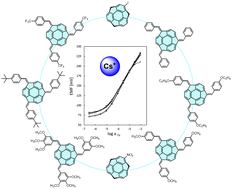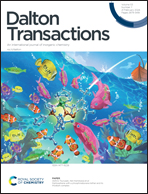Expanding the library of sumanene molecular receptors for caesium-selective potentiometric sensors†
Abstract
This paper reports the synthesis and characterization of eight sumanene molecular receptors for the selective recognition of caesium cations (Cs+). The sumanene derivatives differed in the number (from one to nine), type (electron donating or electron withdrawing) and method of the attachment (functionalization of sumanene at the benzylic or aromatic carbons) of substituents in the sumanene skeleton. The ultimate goal of this work was to investigate the prospective use of various sumanene derivatives in the design of Cs+-selective potentiometric sensors, thus, expanding the library of sumanene receptors for such applications. Spectroscopic fluorescence titration with caesium hexafluorophosphate revealed that the formation of sandwich complexes is highly favourable, but the steric hindrance of bulky substituents can disrupt this preference. In the case of triaryl-substituted sumanene derivatives, theoretical calculations show that, indeed, sandwich complexes are energetically more advantageous by 2.3 times than 1 : 1 complexes. Furthermore, such functionalization significantly increases receptor solubility in the polymeric membrane of the potentiometric sensors, which was quantitatively evaluated with the COSMO model.



 Please wait while we load your content...
Please wait while we load your content...